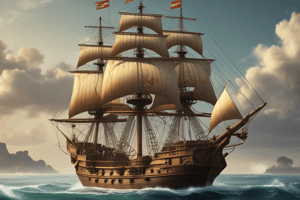Podcast
Questions and Answers
¿Quién lideró la conquista española en las Américas en los siglos XV y XVI?
¿Quién lideró la conquista española en las Américas en los siglos XV y XVI?
- Fernando de Magallanes
- Hernán Cortés (correct)
- Cristóbal Colón
- Francisco Pizarro
¿Qué factor contribuyó significativamente a la disminución de las poblaciones indígenas durante la conquista española?
¿Qué factor contribuyó significativamente a la disminución de las poblaciones indígenas durante la conquista española?
- Enfermedades, guerras y trabajo forzado (correct)
- Alianzas con otras civilizaciones
- Acceso a nuevas tecnologías
- Comercio pacífico
¿Cuál de las siguientes civilizaciones indígenas desapareció como consecuencia directa de la conquista española?
¿Cuál de las siguientes civilizaciones indígenas desapareció como consecuencia directa de la conquista española?
- Azteca (correct)
- Inca
- Maya
- Taino
¿Qué elementos caracterizaron a las civilizaciones indígenas de América antes de la llegada de los españoles?
¿Qué elementos caracterizaron a las civilizaciones indígenas de América antes de la llegada de los españoles?
¿Qué motivó el cambio en las intenciones españolas hacia las poblaciones indígenas americanas durante la conquista?
¿Qué motivó el cambio en las intenciones españolas hacia las poblaciones indígenas americanas durante la conquista?
¿Cuál es el sistema de administración colonial establecido por el Imperio Español para gobernar los territorios recién conquistados?
¿Cuál es el sistema de administración colonial establecido por el Imperio Español para gobernar los territorios recién conquistados?
¿Qué tipo de práctica resultó de la encomienda, donde se exigía tributo a las poblaciones indígenas a cambio de protección?
¿Qué tipo de práctica resultó de la encomienda, donde se exigía tributo a las poblaciones indígenas a cambio de protección?
¿Cuál fue una de las consecuencias principales de la conquista y colonización española en América en términos de población indígena?
¿Cuál fue una de las consecuencias principales de la conquista y colonización española en América en términos de población indígena?
¿Qué elementos introdujeron los pueblos indígenas a los españoles durante el proceso de intercambio cultural?
¿Qué elementos introdujeron los pueblos indígenas a los españoles durante el proceso de intercambio cultural?
¿Qué institución establecida por la Corona Española supervisaba el gobierno local y las actividades eclesiásticas en los territorios recién conquistados?
¿Qué institución establecida por la Corona Española supervisaba el gobierno local y las actividades eclesiásticas en los territorios recién conquistados?
Flashcards are hidden until you start studying
Study Notes
The Spanish Conquest and Colonization of America
In the 15th and 16th centuries, the Spanish Empire embarked on an extensive journey across the Atlantic Ocean, setting in motion a period of profound change for the lands now known as the Americas. This article will explore the Spanish conquest, its impact on native populations, indigenous civilizations, and colonial administration, as well as the cultural exchange that ensued.
Spanish Conquest
The Spanish conquest, spearheaded by the voyages of Christopher Columbus, began in the late 1400s. Initially, the indigenous populations of the Americas were met with curiosity and wonderment. However, as the Spanish sought to exploit the region's resources, their intentions shifted, leading to the imposition of military force and a rapid decline of indigenous populations.
Impact on Native Populations
The Spanish conquest resulted in the loss of an estimated 80-95% of native populations, primarily from warfare, disease, and forced labor. This devastation was particularly acute in regions such as Mexico and Central America. The conquest also led to the disappearance of entire indigenous civilizations, such as the Aztec and Inca Empires.
Indigenous Civilizations
Prior to the arrival of the Spanish, the Americas were home to numerous complex indigenous civilizations, including the Maya, Inca, and Aztec Empires, all of which had advanced societies with developed systems of government, agriculture, and trade. These indigenous civilizations had thriving economies, elaborate religious practices, and unique forms of art and architecture.
Colonial Administration
The Spanish Empire established a complex system of colonial administration to govern the newly conquered territories. This system, known as the encomienda, allowed Spanish conquistadors to claim indigenous populations as their personal property and to demand tribute from them in exchange for their protection. This practice resulted in the exploitation and subjugation of indigenous peoples, and contributed to the rapid decline of indigenous populations.
The Spanish Crown also established formal institutions, such as the Cabildo, to govern the newly conquered territories. The Cabildo was comprised of Spanish officials who oversaw local government, upheld Spanish laws, and supervised the activities of the clergy in the region.
Cultural Exchange
The Spanish conquest and colonization of America also led to a dynamic and complex process of cultural exchange between indigenous peoples and the colonizers. Indigenous peoples introduced the Spanish to new crops, such as corn, potatoes, and beans, while the Spanish introduced indigenous populations to new technologies, such as horses, iron, and the wheel. Indigenous peoples also introduced the Spanish to new forms of art, music, and literature, while the Spanish introduced indigenous populations to new religious practices, such as Christianity.
Legacy
The Spanish conquest and colonization of America had profound and lasting consequences. The rapid decline of indigenous populations, the destruction of indigenous civilizations, and the imposition of colonial administration resulted in a significant shift in the political and cultural landscape of the Americas. The process of cultural exchange between indigenous peoples and the Spanish also resulted in the emergence of a unique and vibrant mestizo culture, which continues to shape the cultural landscape of the Americas to this day.
The Spanish conquest and colonization of America is a complex and multifaceted topic, with significant implications for the history and culture of the Americas. By exploring the Spanish conquest, its impact on native populations, indigenous civilizations, colonial administration, and cultural exchange, we can better understand the legacy of this period and its ongoing implications for the region.
Studying That Suits You
Use AI to generate personalized quizzes and flashcards to suit your learning preferences.




